📋 Group Discussion (GD) Analysis Guide: Is the Indian Economy Ready for Industry 4.0?
🌐 Introduction to Industry 4.0
- 📌 Context Setting: Industry 4.0, the Fourth Industrial Revolution, signifies the integration of advanced technologies such as the Internet of Things (IoT), Artificial Intelligence (AI), robotics, and big data analytics into manufacturing and services. This transformation is reshaping global production and economic competitiveness.
- 📌 Topic Background: Originating in Germany in 2011, Industry 4.0 emphasizes smart factories, automation, and real-time data exchange. In India, it aligns with initiatives like ‘Make in India’ and ‘Digital India’ to modernize the economy.
📊 Quick Facts and Key Statistics
- 📈 Digital Economy Contribution: India’s digital economy is projected to reach $1 trillion by 2030, driven by sectors like IT, e-commerce, and digital payments.
- 📉 IoT Market Growth: The Indian IoT market is expected to grow at a CAGR of 13.2% from 2024 to 2029, reaching significant market size.
- 🤖 Automation Adoption: Approximately 25% of large manufacturers in India have adopted robotics and automation technologies to enhance productivity.
- 🌐 Global Competitiveness: India ranks 60th in the Network Readiness Index 2023, reflecting challenges in digital transformation.
🤝 Stakeholders and Their Roles
- 🏛️ Government: Formulating policies, providing incentives, and funding initiatives like the Production-Linked Incentive (PLI) scheme to promote technology adoption.
- 🏭 Industries: Implementing smart manufacturing practices and adopting advanced technologies to enhance efficiency.
- 📚 Academia: Conducting research and developing curricula to equip the workforce with Industry 4.0 skills.
- 🌍 International Organizations: Collaborating on technology standards and sharing best practices to facilitate global integration.
🏆 Achievements and ⚠️ Challenges
Achievements
- 💡 Technological Advancements: India has emerged as a key player in the global AI race, with significant investments and a robust IT industry.
- 💳 Digital Payment Ecosystem: The Unified Payments Interface (UPI) has revolutionized digital transactions, processing billions monthly and facilitating smoother Industry 4.0 integration.
- 🏗️ Manufacturing Initiatives: The PLI scheme has attracted over $17 billion in investments across 14 sectors, including electronics and pharmaceuticals, boosting domestic manufacturing.
Challenges
- 📚 Skill Gaps: A significant portion of the workforce lacks Industry 4.0-ready skills, necessitating extensive upskilling initiatives.
- 📶 Infrastructure Gaps: Internet penetration in rural areas remains low, hindering widespread adoption of digital technologies.
- 💵 Financial Constraints: High capital requirements pose challenges for small and medium-sized enterprises (SMEs) in adopting advanced technologies.
🌍 Global Comparisons
- 🇩🇪 Germany: Pioneering Industry 4.0 with initiatives like Plattform Industrie 4.0, focusing on smart manufacturing and IoT integration.
- 🇨🇳 China: Leading in smart manufacturing hubs and extensive 5G integration to support Industry 4.0 technologies.
📖 Case Study
- 🏭 Tata Steel’s Smart Plant: By implementing IoT and robotics, Tata Steel enhanced efficiency, reducing operational costs by 15%.
💡 Structured Arguments for Discussion
- Supporting Stance: “India’s robust digital ecosystem, driven by initiatives like UPI and a thriving startup culture, provides a strong foundation for Industry 4.0 adoption.”
- Opposing Stance: “Despite advancements, India’s inadequate infrastructure and significant skill gaps impede its readiness for Industry 4.0.”
- Balanced Perspective: “While India has made notable progress in digital innovation, addressing infrastructure deficiencies and skill shortages is crucial for fully embracing Industry 4.0.”
🗣️ Effective Discussion Approaches
- 📊 Opening Approaches:
- “With India’s IoT market projected to grow significantly, how can the nation overcome rural connectivity challenges to fully embrace Industry 4.0?”
- “As global competitors advance in Industry 4.0, what steps must India take to bridge its skill and infrastructure gaps?”
- 📌 Counter-Argument Handling: Acknowledge existing challenges and propose solutions such as targeted skill development programs and investment in digital infrastructure.
📈 Strategic Analysis of Strengths and Weaknesses
- Strengths: Thriving startup ecosystem, supportive government policies, and a large, youthful workforce.
- Weaknesses: Limited digital infrastructure in rural areas, skill shortages, and financial constraints for SMEs.
- Opportunities: Potential for global collaboration, leadership in AI and IoT, and leveraging demographic dividends.
- Threats: Rising competition from other nations, cybersecurity risks, and potential socio-economic disparities.
🎓 Connecting with B-School Applications
- 🌍 Real-World Applications: Exploring the impact of Industry 4.0 on supply chain management, operations, and strategic decision-making in businesses.
- 📚 Sample Questions:
- “How can Industry 4.0 transform India’s manufacturing sector?”
- “What role do startups play in driving Industry 4.0 adoption in India?”
- 💡 Insights for Students: Emphasize the importance of understanding digital transformation, innovation management, and the integration of advanced technologies in business strategies.


